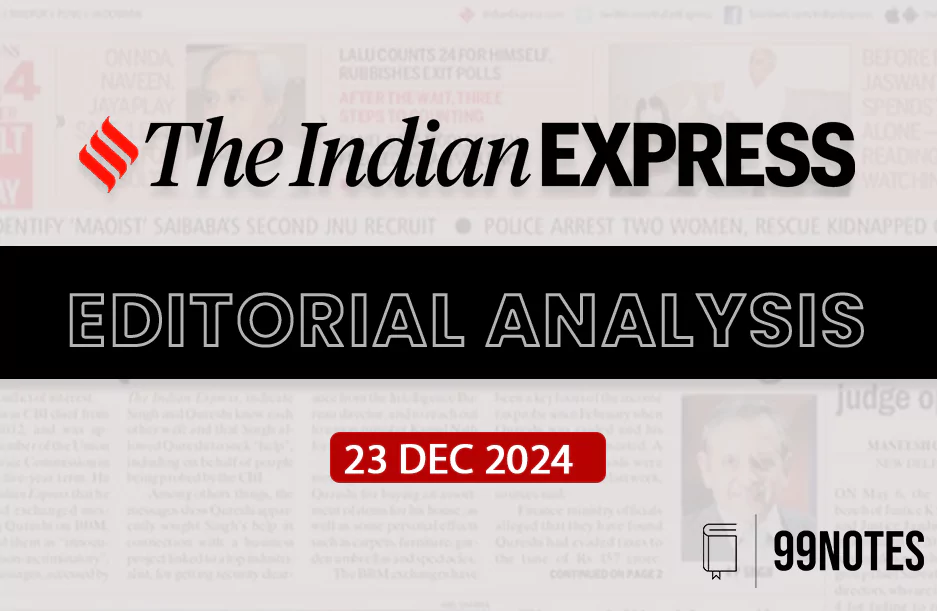23 December 2024 : Indian Express Editorial Analysis
1. Farms as sites of nurturing
(Source: Indian Express; Section: The Ideas Page; Page: 13)
| Topic: GS3 – Agriculture |
| Context |
|
Enhancing Agricultural Productivity and Resilience
- The Union Budget 2025-26 presents an opportunity to address critical challenges in agriculture while making the sector more productive, competitive, remunerative, and sustainable.
- A major focus should be on combating climate change impacts on agriculture.
- With rising temperatures and declining monsoon precipitation, climate-resilient agriculture becomes paramount.
- Allocating more resources for agricultural R&D, doubling its share from less than 0.5% to at least 1% of the agri-GDP, is essential.
- Furthermore, improving soil health through balanced fertilisation, incorporating biofertilisers, and promoting technologies like nano-urea can enhance productivity sustainably.
- Revising the current fertiliser subsidy policy to avoid overuse of nitrogen-based fertilisers and incentivize balanced nutrient application will be pivotal.
Reforming Fertiliser Policies
- The fertiliser subsidy structure has led to excessive use of nitrogen while neglecting other critical nutrients like phosphorus and potassium.
- Direct income transfers to farmers on a per-hectare basis could replace the existing subsidy framework.
- This reform would free fertiliser prices from controls, restore nutrient balance, and curb misuse, resulting in environmental and economic benefits.
- Leveraging data from soil health cards, fertiliser sales, and PM-KISAN could ensure targeted support.
- Building trust among farmers through effective communication and transparent implementation is key to success.
Strengthening Agricultural Value Chains
- Agriculture needs to be viewed as an integrated food system encompassing production, marketing, and consumption.
- Enhancing farmers’ share in consumer prices through robust value chains, similar to the milk sector, is critical.
- Starting with fruits and vegetables, which currently yield only one-third of consumer prices to farmers, can revolutionize the sector.
- Establishing a dedicated board like the NDDB for fruits and vegetables, led by visionary leadership, could drive transformative changes akin to the White Revolution.
Rationalizing Market and Export Policies
- India’s agri-policies often penalize farmers through erratic export controls and domestic market interventions, reflecting a pro-consumer bias.
- Practices like banning exports of onions, wheat, and sugar or dumping rice and wheat in the domestic market below economic costs suppress farm incomes.
- Such anti-market actions, coupled with stocking limits and futures market restrictions, lead to a negative Producer Support Estimate (PSE) of -15.5% for Indian farmers, compared to 14% in China and OECD nations.
- Rationalising these policies to support market dynamics and ensure fair pricing for farmers is imperative.
Prioritizing Sustainable Agriculture
- The Natural Farming Mission, though promising, cannot solely sustain India’s growing population.
- Policies must integrate sustainability with scalability. Encouraging organic carbon retention in soils, efficient irrigation practices, and resource-use efficiency will support long-term agricultural health.
- Additionally, fostering innovations in agri-tech and precision farming can amplify productivity while reducing environmental footprints.
Policy Directions for Union Budget 2025-26
- Increased Budget Allocation for R&D: Doubling the agri-R&D allocation to address climate challenges.
- Reforming Subsidies: Transitioning to direct income transfers and promoting balanced fertiliser use.
- Building Value Chains: Establishing a dedicated body for fruits and vegetables to replicate the success of the dairy sector.
- Rational Export Policies: Removing export controls and aligning policies to market dynamics to eliminate implicit taxes on farmers.
- Focus on Sustainability: Integrating soil health, water conservation, and climate-resilient practices into mainstream policies.
By addressing these areas, the government can lay the groundwork for a more robust, equitable, and sustainable agricultural framework that ensures food security, farmer welfare, and environmental preservation.
| What Should be the Steps Ahead to Reform the Farm Sector in India? |
Holistic Agricultural Approach:
Value Chain Development:
Access to Technologies and Markets:
Reform Fertiliser Subsidy:
Inclusive Growth and Social Security
Creating Climate Resilient Agriculture:
|
| PYQ: How far is the Integrated Farming System (IFS) helpful in sustaining agricultural production? (150 words/10m) (UPSC CSE (M) GS-3 2019) |
| Practice Question: Discuss the key challenges faced by Indian agriculture in the context of climate change and resource mismanagement. Suggest policy measures that the Union Budget 2025-26 can incorporate to enhance agricultural productivity, ensure farmer welfare, and promote sustainability. (250 words/15 m) |
For more such UPSC related Current Affairs, Check Out: 21 December 2024 : Indian Express Editorial Analysis





